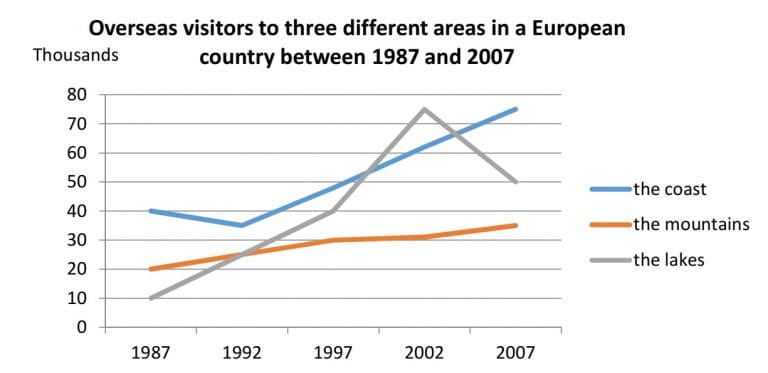[NGUYEN HUNG D] Writing Practice Test 1469019
Task 1
You should spend about 20 minutes on this task.
The graph below shows the number of overseas visitors to three different areas in a European country between 1987 and 2007
Summarise the information by selecting and reporting the main features, and make comparisons where relevant.
You should write at least 150 words.

The provided data illustrates the influx of foreign tourists across three distinct geographical areas within a specific European nation from 1987 to 2007.
Primarily, coastal regions emerged as the most favored destination for foreign visitors throughout most of the surveyed years, whereas mountainous locales generally exhibited lower appeal. Notably, the visitor count increased across all three areas throughout the specified timeframe.
In 1987, approximately 40,000 foreign tourists explored the coastal regions of this European country. This number experienced a slight decline to roughly 35,000 visitors by 1992 before progressively ascending, reaching approximately 75,000 tourists by 2007. Conversely, the influx of foreign tourists to mountainous areas fluctuated between 20,000 and 30,000 during the initial years before experiencing a gradual increase, culminating at around 35,000 visitors by 2007.
Meanwhile, the number of foreign tourists venturing into the lakeside regions of this nation steadily ascended over the initial fifteen years, reaching a zenith of 75,000 visitors in 2002. However, this figure exhibited a notable decline in the subsequent years, dwindling to 50,000 visitors by 2007.
Task 2
You should spend about 40 minutes on this task.
Some countries achieve international sports by building specialised facilities to train top athletes, instead of providing sports facilities that everyone can use. Do you think this is positive or negative development?
Discuss both views and give your opinion.
You should write at least 250 words.
There are divergent views regarding whether focusing on building specialized facilities to train top athletes, rather than providing sports facilities accessible to everyone, constitutes a positive or negative development. This essay will examine both perspectives before presenting a reasoned opinion.
On the one hand, proponents argue that investing in specialized training facilities can yield substantial benefits for a nation's sporting achievements. By concentrating resources on high-performance centers, countries can cultivate elite athletes who excel on the international stage. These facilities offer state-of-the-art equipment, expert coaching, and tailored programs designed to maximize athletic potential. Consequently, this approach may enhance a country's prestige and competitiveness in global sporting events, fostering national pride and unity.
Conversely, critics contend that prioritizing specialized facilities may exacerbate inequalities in access to sports and undermine grassroots participation. When resources are disproportionately allocated to elite athletes, recreational sports facilities for the general public may be neglected or underfunded. This disparity not only restricts opportunities for ordinary citizens to engage in physical activity but also perpetuates socioeconomic divides. Furthermore, a narrow focus on elite training may overlook the broader benefits of sports in promoting health, social cohesion, and personal development among all segments of society.
In my opinion, while specialized facilities play a crucial role in nurturing top-tier athletes and enhancing a country's sporting prowess, they should not overshadow the importance of inclusive sports infrastructure. A balanced approach that caters to both elite training and community participation is preferable. Governments should allocate resources judiciously to develop a comprehensive sports ecosystem that accommodates the diverse needs and interests of their populace. By fostering a culture of sports for all, nations can harness the power of athletics to promote physical well-being, social integration, and national identity.
In conclusion, the debate over the emphasis on specialized sports facilities versus inclusive sports infrastructure is multifaceted. While specialized facilities can elevate a country's international sporting achievements, they should be complemented by accessible facilities that cater to the broader population. Striking a balance between elite training and grassroots participation is essential to realizing the full potential of sports as a catalyst for individual and societal development.
社区反馈
抱歉!暂无收到用户评论
社区评分
评分排行榜:
| # | 用户 | 得分 | 时间 | |
|---|---|---|---|---|
| Yuki Arai |  | 7.0 | 00:35 | |
| Rie Kimoto |  | 6.0 | 52:48 | |
| Salina Tang |  | 6.0 | 57:08 | |
| 4 | Refan Alsuhaibani |  | 5.5 | 59:59 |



